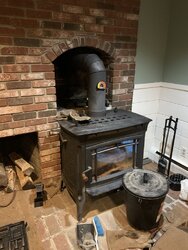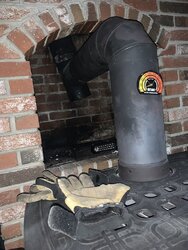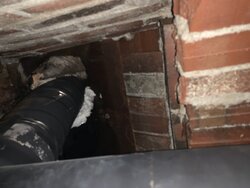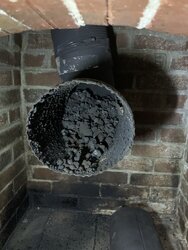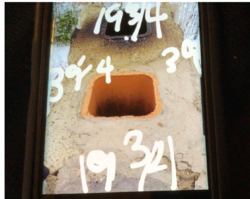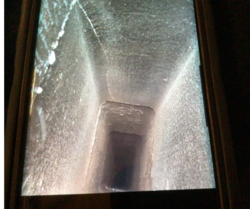I just had my chimney swept and they took pics of the crack in my flue liner and suggested I replace with stainless steel ... at a big cost for me at $3000. They want to remove the old flue tiles. The crack does not look that bad to me; sort of hairline. How critical is this? I see a post on the sticky section that a person could do this themselves though I could not remove the old tiles. Is this really serious? So many people in my area clean their flues themselves and I don't hear of any homes burning down or people dying because of a crack in their flue. What am I missing?
crack in flue liner
- Thread starter nhparadise
- Start date
-
Active since 1995, Hearth.com is THE place on the internet for free information and advice about wood stoves, pellet stoves and other energy saving equipment.
We strive to provide opinions, articles, discussions and history related to Hearth Products and in a more general sense, energy issues.
We promote the EFFICIENT, RESPONSIBLE, CLEAN and SAFE use of all fuels, whether renewable or fossil.
You are using an out of date browser. It may not display this or other websites correctly.
You should upgrade or use an alternative browser.
You should upgrade or use an alternative browser.
Ctwoodtick
Minister of Fire
If liner is cracked, then replacing is needed. It would be money well spent.I just had my chimney swept and they took pics of the crack in my flue liner and suggested I replace with stainless steel ... at a big cost for me at $3000. They want to remove the old flue tiles. The crack does not look that bad to me; sort of hairline. How critical is this? I see a post on the sticky section that a person could do this themselves though I could not remove the old tiles. Is this really serious? So many people in my area clean their flues themselves and I don't hear of any homes burning down or people dying because of a crack in their flue. What am I missing?
jatoxico
Minister of Fire
Just for the purpose of full understanding, how are you burning, open fire or stove/insert of some type? $3K to remove old tile and replace doesn't sound too bad IMO.
Supersurvey
Feeling the Heat
Do you have room to install a stainless steel liner without removing the clay tiles? I beliece that would be preferred.
Probably not with insulation. No one is going to break out clay tiles for fun.Do you have room to install a stainless steel liner without removing the clay tiles? I beliece that would be preferred.
I burn wood with a Hearthstone Shelburne.
Just for the purpose of full understanding, how are you burning, open fire or stove/insert of some type? $3K to remove old tile and replace doesn't sound too bad IMO.
I agree that removing the old tile is worth a price and beyond my pay grade. I'm just shocked at the price and would prefer to do it myself if at all possible. I will have to wait for spring as I'm not climbing onto my metal roof in the current conditions. Maybe breaking out the tile is necessary; I don't know.
The thing I wonder is - and knowing my neighbors who don't spend a dime they don't have to and this would be out of the question for them - how many cracked liners never cause a problem? My flue is surrounded by cement blocks and on top of that, inside, is stone. edit: inside meaning inside the house.
Would a plan be to sweep the chimney more often - at least twice a year - to keep the flue clean? I saw how they did it and I'm confident I can sweep the chimney myself now.
The thing I wonder is - and knowing my neighbors who don't spend a dime they don't have to and this would be out of the question for them - how many cracked liners never cause a problem? My flue is surrounded by cement blocks and on top of that, inside, is stone. edit: inside meaning inside the house.
Would a plan be to sweep the chimney more often - at least twice a year - to keep the flue clean? I saw how they did it and I'm confident I can sweep the chimney myself now.
Do you have room to install a stainless steel liner without removing the clay tiles? I beliece that would be preferred.
If liner is cracked, then replacing is needed. It would be money well spent.
Last edited:
jatoxico
Minister of Fire
Doesn't that need a liner anyway? How do you have it vented now, into the old clay chimney?I burn wood with a Hearthstone Shelburne.
Jar5089
New Member
Following this post. I have a similar setup where it is a partial liner and vents to the old 8” clay chimney. Been doing this for 4 years. I’m having an issue where it is creating a lot of creosote build up at the tee. Wood is dry 2 years. Input is appreciated!
Attachments
Jar5089
New Member
Forgot to attach picture of creosote after a little over 2 months of burning.Following this post. I have a similar setup where it is a partial liner and vents to the old 8” clay chimney. Been doing this for 4 years. I’m having an issue where it is creating a lot of creosote build up at the tee. Wood is dry 2 years. Input is appreciated!
Attachments
SOP for the company may be knocking out the old clay liner. They use a tool on extensions with a drill. I was able to fit insulated Duraliner rigid oval inside my flue, but it was a straight shot. Liner cost as much or more than the stove doing both myself without knocking the old flue out.
Supersurvey
Feeling the Heat
Clay in good condition and built properly to start with and with the stove installed properly is perfectly acceptable to vent a woodstove into.Doesn't that need a liner anyway? How do you have it vented now, into the old clay chimney?
Sop if an insulated liner will not fit yes. There is no reason not to remove the clay it serves no purpose after the stainless is installed.SOP for the company may be knocking out the old clay liner. They use a tool on extensions with a drill. I was able to fit insulated Duraliner rigid oval inside my flue, but it was a straight shot. Liner cost as much or more than the stove doing both myself without knocking the old flue out.
jatoxico
Minister of Fire
I was thinking from a sizing standpoint. Wouldn't the clay would have to have the cross sectional area of a 6" liner give or take?Clay in good condition and built properly to start with and with the stove installed properly is perfectly acceptable to vent a woodstove into.
Many stoves allow them to upsize to an 8x8 clay.I was thinking from a sizing standpoint. Wouldn't the clay would have to have the cross sectional area of a 6" liner give or take?
Here are some pics that the chimney sweep took. It looks like just one tile is cracked. Also, the quote said "Pre-Insulated 316 Ti-Alloy 6" should that help. What does SOP mean???
Until we know the tile dimentions of the tiles were just guessing on the best approach.
Attachments
sticker shock for me again as this pipe is over $1000 if I buy it myself, so the $3000 quote is probably not out of line with breaking out the old tiles. For now I'm taking my chances. I'm going to use my stove through the winter and I have a hard time believing I will burn my house down. I hope I haven't jinxed myself!
When I had a quote done an oval liner inside the clay wasn't an option. I paid less for a new stove and insulated liner I did myself than just the liner quote was.
I am confused by the picture of a chimney with 2 8x8 liners then a pic of an 8x12 that doesn't look like it is used for wood with a crack in itsticker shock for me again as this pipe is over $1000 if I buy it myself, so the $3000 quote is probably not out of line with breaking out the old tiles. For now I'm taking my chances. I'm going to use my stove through the winter and I have a hard time believing I will burn my house down. I hope I haven't jinxed myself!
Never mind I looked at is again the top shot is an 8x12 with the wood staining. Still not sure why the pic with the crack doesn't show any wood staining.
But yes houses do burn down all the time due to chimney issues. Sometimes cracks but it is usually lack of proper clearance from the chimney.
Last edited:
The chimney is for both an oil furnace and the wood stove. I don't know anything about the wood staining but that is the inside shot of the wood burning part of my chimney.
So, is the 8x12 (now that I know what it is, so thanks) big enough to get the pre-insulated 6" pipe down it without having to break out the old tiles?
So, is the 8x12 (now that I know what it is, so thanks) big enough to get the pre-insulated 6" pipe down it without having to break out the old tiles?
Never mind I looked at is again the top shot is an 8x12 with the wood staining. Still not sure why the pic with the crack doesn't show any wood staining.
But yes houses do burn down all the time due to chimney issues. Sometimes cracks but it is usually lack of proper clearance from the chimney.
you would have to look up the outside diameter of the various insulated liners on the market. The outside dia . of mine ( ridged pipe sections) is 10". $3k is about average for the job. The tool for busting out the liner tiles is apx 4x4x/3/8' or so sq. plate with a connector for the rods welded on slightly offset from center. Busting out the tiles is the easy part cleaning all the busted pieces up from down below and carrying them out is a pain. Then getting that snake back down is the next fun part. Ran me about $5000 apx 9 years ago, that included re- bricking the external portion of the flue as all the mortar was shot between the face bricks. I would have opted for a bit different approach but local ord. required things to be just as they were externally. (!@#$%^&)
Not a 6" insulated round no. But an insulated y" equivalent oval should work.The chimney is for both an oil furnace and the wood stove. I don't know anything about the wood staining but that is the inside shot of the wood burning part of my chimney.
So, is the 8x12 (now that I know what it is, so thanks) big enough to get the pre-insulated 6" pipe down it without having to break out the old tiles?
As someone who breaks out lots of liners the breakout can be easy or really difficult it depends upon how much space is around the tiles. And not many pros use the offset breakers anymore. We all use the ones with chain and balls on the ends. They are much easier on the chimney and the person running the breaker.you would have to look up the outside diameter of the various insulated liners on the market. The outside dia . of mine ( ridged pipe sections) is 10". $3k is about average for the job. The tool for busting out the liner tiles is apx 4x4x/3/8' or so sq. plate with a connector for the rods welded on slightly offset from center. Busting out the tiles is the easy part cleaning all the busted pieces up from down below and carrying them out is a pain. Then getting that snake back down is the next fun part. Ran me about $5000 apx 9 years ago, that included re- bricking the external portion of the flue as all the mortar was shot between the face bricks. I would have opted for a bit different approach but local ord. required things to be just as they were externally. (!@#$%^&)
10 years ago this is a job I would have taken on myself. I'm too tired for it now and don't need the frustration that would surely go with it. I will have to look at measurements in the spring. It would be great if taking out the liner is not necessary.
you would have to look up the outside diameter of the various insulated liners on the market. The outside dia . of mine ( ridged pipe sections) is 10". $3k is about average for the job. The tool for busting out the liner tiles is apx 4x4x/3/8' or so sq. plate with a connector for the rods welded on slightly offset from center. Busting out the tiles is the easy part cleaning all the busted pieces up from down below and carrying them out is a pain. Then getting that snake back down is the next fun part. Ran me about $5000 apx 9 years ago, that included re- bricking the external portion of the flue as all the mortar was shot between the face bricks. I would have opted for a bit different approach but local ord. required things to be just as they were externally. (!@#$%^&)
Similar threads
- Replies
- 2
- Views
- 506
- Replies
- 1
- Views
- 360
- Replies
- 13
- Views
- 1K
- Replies
- 25
- Views
- 1K


